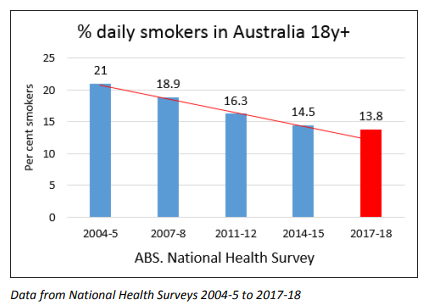Smoking rates stall as Australia loses the battle against smoking
After years of steadily declining smoking rates, Australia is now losing the battle against smoking. The National Health Survey (1) released today by the Australian Bureau of Statistics has confirmed once again that smoking rates have stalled and the national target levels have not been met.
According to the survey, 15.2% of Australians adults (18 years and older) smoked in 2017-18 compared to 16% in 2014-15 (2). These findings are consistent with other Australian national (3) and state surveys which have shown that smoking rates have stagnated since 2013 and are rising in NSW (4) and SA (5).
‘This is very disappointing’ said Associate Professor Colin Mendelsohn, chairman of the Australian Tobacco Harm Reduction Association (ATHRA). ‘The decline in daily smoking over the last 3 years was one third of the long-term trend since 2004’.
The daily smoking rate for adult Australians is now 13.8%, well above the 10% daily adult smoking target set for 2018 by the Council of Australian Governments (COAG) (6) in 2008’. (see table below) ‘Australia has the highest cigarette prices in the world, plain packaging and strict tobacco control laws. However, additional effective strategies are now needed to get things moving again’ Dr Mendelsohn said.
‘Smoking is a priority issue as it remains the leading preventable cause of death and illness in Australia, killing 19,000 Australian smokers prematurely every year.’
According to Dr Joe Kosterich, a Director of ATHRA, ‘The difference between Australia and other high income countries is Australia’s ban on tobacco harm reduction strategies, ie the use of safer nicotine products like nicotine vaporisers (e-cigarettes) for smokers who are unable to quit’.
‘Smoking rates are dropping faster than ever in many of these other countries. There is good evidence that vaping is contributing to this rapid decline’, he said.
‘Many smokers are simply unable or unwilling to quit smoking or nicotine with current treatments. We need to make acceptable, less harmful alternatives available to reduce the risks for these smokers’ he said. ‘Vaporisers allow smokers to enjoy an experience similar to smoking, with a greatly reduced risk of harm and reduced cost’.
‘Two out of three continuing smokers will die prematurely from a smoking-related disease, so reducing that risk is a priority’ Dr Kosterich said.
The harm from smoking is disproportionately experienced by disadvantaged populations with high smoking rates such as Indigenous people, people living with mental illness or substance use, low income people and the homeless
Contact
Associate Professor Colin Mendelsohn
M: 0415 976 783 | E: c.mendelsohn@unsw.edu.au
Dr Joe Kosterich
M: 0417 998 697 | E: joe@drjoe.net.au

What is ATHRA?
Australian Tobacco Harm Reduction Association (ATHRA) is a registered health promotion charity established to reduce the harm from tobacco smoking in Australia. ATHRA aims to raise awareness of less harmful alternatives for adult smokers who are otherwise unable to quit. ATHRA’s broader goal is to encourage the complete cessation of tobacco smoking in Australia. For more information, visit www.athra.org.au.
ATHRA is funded by unconditional donations from businesses and the general public. It does not accept donations from tobacco companies or their subsidiaries. None of the directors has ever had any financial or commercial relationship with any electronic cigarette or tobacco company.
References
1. Australian Bureau of Statistics. National Health Survey: First Results, 2017-18. Catalogue no 4364 0.55.001. 2018. Available at: http://www.abs.gov.au/ausstats/abs@.nsf/Lookup/by%20Subject/4364.0.55.001~2017- 18~Main%20Features~Smoking~85
2. Australian Bureau of Statistics. National Health Survey: First Results, 2014-15. ABS Catalogue No. 4364.0.55.001. Commonwealth of Australia. 2015.Available at: http://www.abs.gov.au/ausstats/abs@.nsf/Lookup/by%20Subject/4364.0.55.001~2014- 15~Main%20Features~Smoking~24#
3. Australian Institute of Health and Welfare. National Drug Strategy Household Survey (NDSHS) 2016: detailed findings. Drug Statistics series no. 31. Cat. no. PHE 214. Canberra: AIHW, 2017. Available at: https://www.aihw.gov.au/getmedia/15db8c15-7062-4cde-bfa4- 3c2079f30af3/21028.pdf.aspx?inline=true. Accessed 24 June 2018
4. New South Wales Ministry of Health. Health Stats, NSW Adult Population Health Survey. 2017. Available at: http://www.healthstats.nsw.gov.au/Indicator/beh_smocat/beh_smocat_comparison
5. Martin K, J. B, Miller C. Key Smoking Statistics for SA – 2017 Adelaide, Australia. South Australian Health and Medical Research Institute (SAHMRI), April 2018. Available at: https://www.sahmri.org/m/downloads/Key_Smoking_Statistics_for_SA_2017_-_April_2018.pdf
6. Council of Australian Governments (COAG). National Healthcare Agreement. 2008. Available at: https://www.pc.gov.au/research/supporting/nationalagreements/healthcare/healthcare-agreement-2009.pdf